Philippines Ranks 50th in GII 2025: A Blockchain Powerhouse Emerging?

Philippines Hits 50th in Global Innovation Index 2025: A Blockchain Powerhouse in the Making?
The Philippines has just pulled off a stunner, soaring to the 50th spot in the Global Innovation Index (GII) 2025 out of 139 economies, according to the World Intellectual Property Organization (WIPO). This is the country’s highest ranking ever, smashing its own target of 52nd under the Philippine Development Plan (PDP) 2023–2028. More than just a number, this leap signals a robust innovation ecosystem that could position the nation as a serious player in decentralized tech like blockchain and cryptocurrency.
- Major Milestone: Philippines secures 50th in GII 2025, exceeding its PDP goal and hitting a historic high.
- Tech Strengths: Dominates globally in high-tech exports and sees a 350% jump in international patent filings.
- Crypto Opportunity: ICT prowess and innovation momentum hint at big potential for blockchain adoption.
A Steady Climb with Global Impact
This isn’t a fluke. The Philippines has been grinding its way up the innovation ladder for over a decade, from a lackluster 90th place in 2013 to 59th in 2022, 56th in 2023, 53rd in 2024, and now 50th in 2025—matching its peak performance from 2020. That consistency has earned it the “Innovation Overperformer” label for seven straight years among lower middle-income economies. Ranked third in its income bracket, alongside giants like China, India, and Indonesia, the country is showing that innovation isn’t just a rich nation’s playground. It’s a battlefield where determination and strategy can level the odds.
The GII measures innovation through two lenses: Inputs, think of these as the ingredients and kitchen setup for cooking, and Outputs, the actual meal you serve. The Philippines ranked 59th in Inputs and a stronger 49th in Outputs, both improvements over last year. Where it really flexes is in trade metrics. It’s number one—yes, first globally—in high-tech exports as a share of total trade. It also ranks fourth in high-tech imports, 16th in creative goods exports, and 20th in ICT services exports. Add to that a jaw-dropping 350% surge in international patent filings between 2023 and 2024, and you’ve got a nation poised to export not just goods, but ideas. For more details on this remarkable achievement, check out the report on the Philippines’ rise to 50th in the Global Innovation Index.
Cracks in the Foundation: Challenges Ahead
But hold the confetti. There are glaring weak spots that could trip up this momentum. The country ranks a dismal 90th in human capital and research, 65th in infrastructure, and 61st in institutions and creative outputs. That’s not just a red flag—it’s a neon sign screaming, “Fix this or forget sustained growth!” Without a skilled workforce, reliable digital and physical infrastructure, and solid governance, climbing higher—or even holding this spot—could be a fantasy. Imagine trying to build a blockchain ecosystem when rural internet is spotty at best. Good luck with that.
The government isn’t blind to these issues. Through the National Innovation Council (NIC), chaired by President Ferdinand Marcos Jr., and the National Innovation Agenda and Strategy Document (NIASD) 2023–2032, there’s a clear push to pump up research and development (R&D) investment, upgrade science and tech infrastructure, and craft a business environment that doesn’t choke innovation. It’s a tall order, but the intent is there.
“Surpassing our 2025 target is the result of sustained reforms, targeted investments, and strong collaboration across sectors and key players in the country’s innovation ecosystem. We remain committed to scaling our innovation capacity, bridging critical gaps in research and digital infrastructure, and ensuring that innovation drives inclusive and sustainable development,” said Arsenio Balisacan, DEPDev Secretary and NIC Vice Chair.
Intellectual Property as the Unsung Hero
One piece of the puzzle getting extra focus is intellectual property (IP), often overlooked but critical for protecting creators and fueling economic growth. The Intellectual Property Office of the Philippines (IPOPHL) is on a mission to make IP an equalizer, accessible to everyone from street artists to tech startups. Director General Brigitte da Costa-Villaluz laid it out plain and simple:
“We are encouraged to educate more, and we always say IP is an equalizer—anyone can create, and anyone can be protected by IP. That is really the societal impact that we aim for, to make IP an enabler of economic growth, and show Filipinos what they can really do.”
This emphasis on IP ties directly into fostering a culture of innovation, ensuring that breakthroughs—whether in high-tech or creative fields—are safeguarded and monetized for the benefit of all, not just a select few.
Blockchain and Crypto: The Next Frontier for Filipinnovation?
Now let’s get to the meat that our readers are hungry for: could this innovation wave make the Philippines a blockchain and crypto hotspot? With top-tier rankings in ICT services and high-tech integration, the answer feels like a loud yes. For the uninitiated, blockchain is a decentralized ledger tech that underpins cryptocurrencies like Bitcoin, enabling secure, transparent systems for everything from money transfers to supply chain tracking. Smart contracts, for instance, are self-executing digital agreements that cut out middlemen by automatically enforcing terms. Tokenized assets? They’re digital versions of real-world value—like art or property—traded on a blockchain.
The Philippines is already ripe for this disruption. Take remittances, a lifeline for millions of overseas Filipino workers (OFWs) who send money home, often paying hefty fees of 6-7% through traditional channels like banks or Western Union. Blockchain can slash those costs to near-zero using stablecoins like USDT or even Bitcoin, delivering funds instantly. With roughly 50% of the population unbanked—meaning they lack access to traditional banking, often in rural areas—crypto offers a way to bring financial services to the masses via a smartphone and an internet connection. Then there’s trade: imagine smart contracts streamlining the country’s high-tech export deals, cutting bureaucracy and boosting transparency.
Real-world precedents exist. The Philippines saw early Bitcoin adoption for remittances years ago, and play-to-earn games like Axie Infinity exploded locally, showing how crypto can empower individuals economically. If “Filipinnovation”—as some are dubbing this surge—embraces decentralized tech, the country could become a Southeast Asia blockchain hub, rivaling places like Singapore or Thailand. Blockchain isn’t just tech; it’s a middle finger to centralized systems that overcharge and underdeliver, especially for a remittance-heavy economy like this one.
The Flip Side: Don’t Ignore the Risks
Before we start dreaming of a crypto utopia, let’s keep it real. Blockchain adoption isn’t a silver bullet, and the Philippines isn’t ready to roll out the red carpet just yet. That 65th ranking in infrastructure? It’s a brutal reminder that spotty internet and power issues in rural areas could tank any decentralized tech rollout. Then there’s the regulatory minefield. While the Bangko Sentral ng Pilipinas (BSP) has frameworks for virtual asset service providers (VASPs), balancing innovation with consumer protection is a tightrope walk. Without clear, robust policies, you’re begging for chaos.
And let’s talk scams—crypto Ponzi schemes and rug pulls have burned countless folks in this region. Think back to the notorious scams that promised “guaranteed returns” only to vanish with investors’ cash. If the government pushes blockchain without ironclad protections and public education, it’s a recipe for disaster. We’re all for disruption, but not the kind that leaves people broke and bitter. Any crypto push must prioritize security and literacy, or it’s just hype waiting to implode.
Where Does This Leave Us?
The Philippines is at a pivotal moment. Hitting 50th in the GII 2025 is a massive win, a testament to grit and vision amid global headwinds. But maintaining this trajectory means tackling the ugly stuff—human capital, infrastructure, governance—head-on. And if blockchain and crypto are to play a starring role, they can’t be a shiny afterthought. They need to be baked into national strategies with serious investment and oversight.
Looking globally, developing economies are increasingly turning to blockchain as a tool for resilience—whether it’s Bitcoin as a hedge against unstable currencies or decentralized finance (DeFi) unlocking capital for the underserved. The Philippines, with its tech strengths and innovation hunger, could lead that charge in Southeast Asia. But policy missteps or unchecked scams could tank this before it even starts. So yeah, the future of “Filipinnovation” looks bright, but it’s not a done deal. The road ahead demands relentless focus—and a healthy dose of skepticism.
Key Takeaways and Questions to Ponder
- What does the Philippines’ 50th GII ranking signal for its future?
It’s a sign of growing strength in global markets, especially in high-tech and creative sectors, setting the stage for sustainable economic growth if weaknesses are addressed. - How is the government fueling this innovation surge?
Via the National Innovation Council and NIASD 2023–2032, prioritizing R&D, tech infrastructure upgrades, and policies that welcome business innovation. - What are the biggest roadblocks to lasting progress?
Low rankings in human capital, research, and infrastructure spotlight critical gaps that could derail momentum without swift, decisive action. - Can blockchain and crypto boost the Philippines’ innovation edge?
Without a doubt—given ICT strengths, blockchain could transform remittances, trade transparency, and financial inclusion, provided regulation and infrastructure keep pace. - What specific blockchain use cases fit the Philippines’ strengths?
Smart contracts for high-tech trade deals, crypto for low-cost remittances, and tokenized assets for creative exports could align perfectly with existing capabilities. - How can the government foster crypto adoption without the scams?
By enforcing strict VASP regulations, investing in public education on crypto risks, and learning from past regional scams to build trust in decentralized systems.



